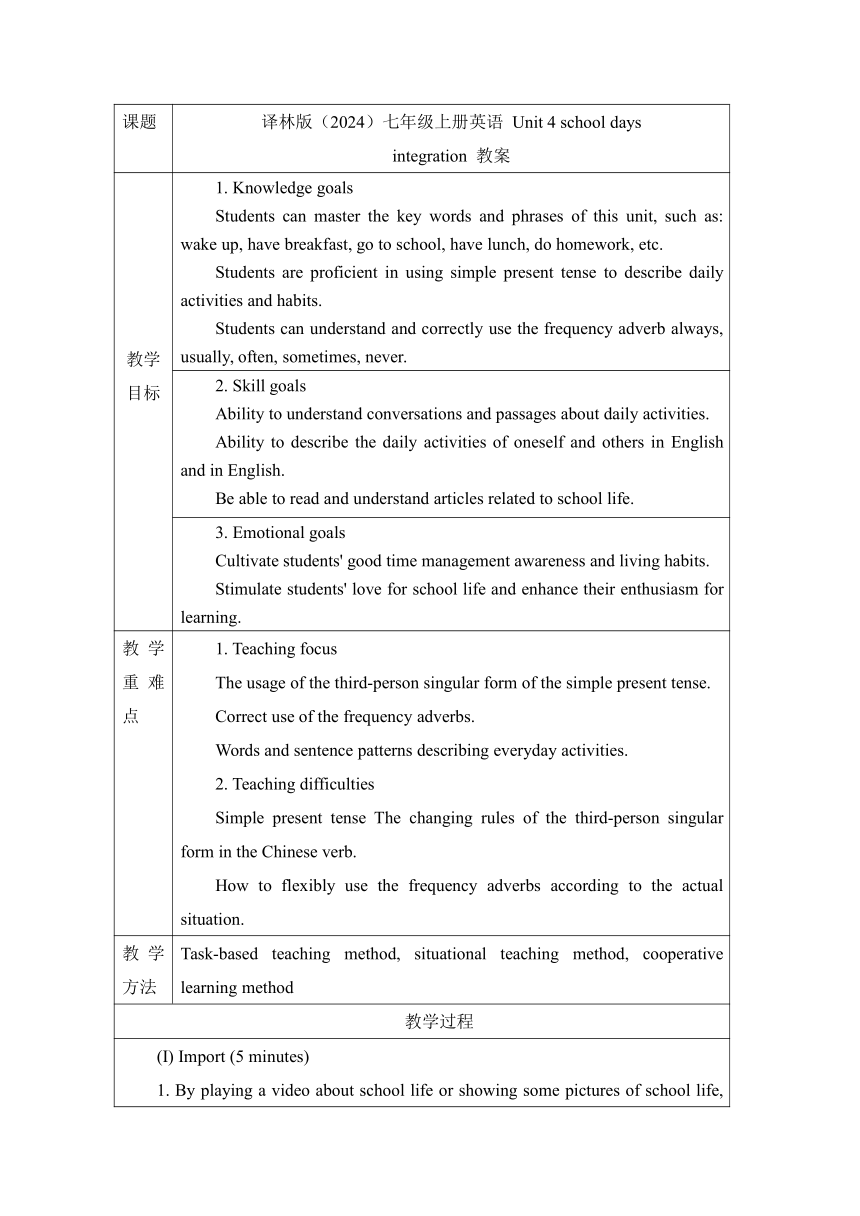 资源简介
资源简介
课题 译林版(2024)七年级上册英语 Unit 4 school days integration 教案
教学目标 1. Knowledge goals Students can master the key words and phrases of this unit, such as: wake up, have breakfast, go to school, have lunch, do homework, etc. Students are proficient in using simple present tense to describe daily activities and habits. Students can understand and correctly use the frequency adverb always, usually, often, sometimes, never.
2. Skill goals Ability to understand conversations and passages about daily activities. Ability to describe the daily activities of oneself and others in English and in English. Be able to read and understand articles related to school life.
3. Emotional goals Cultivate students' good time management awareness and living habits. Stimulate students' love for school life and enhance their enthusiasm for learning.
教学重难点 1. Teaching focus The usage of the third-person singular form of the simple present tense. Correct use of the frequency adverbs. Words and sentence patterns describing everyday activities. 2. Teaching difficulties Simple present tense The changing rules of the third-person singular form in the Chinese verb. How to flexibly use the frequency adverbs according to the actual situation.
教学方法 Task-based teaching method, situational teaching method, cooperative learning method
教学过程
(I) Import (5 minutes) 1. By playing a video about school life or showing some pictures of school life, guide the students to recall and discuss their school day, such as when to get up in the morning, when to attend class, what to eat at noon, etc. 2. Ask the students: What do you do at school every day Students are encouraged to answer in English, thus leading to the topic ——School Days of this unit. (Ii) Word learning (10 minutes) 1. Show the key words and phrases of this unit, such as: wake up, have breakfast, go to school, have lunch, do homework, etc., and lead the students to read aloud and explain its meaning and usage. For example: wake up means "waking up", the common phrase wake up early / late (early / late). have breakfast Means "eat breakfast", similar phrases include have lunch (lunch), have dinner (dinner). 2. Help students understand and remember words through pictures, actions or example sentences. For example: show a picture of a person getting up, say: He wakes up at six o'clock. Make the eating action, say: I have breakfast at seven. (3) Grammar explanation (15 minutes) 1. General present tense Explain the concept and usage of simple present tense, and emphasize the frequent action or state of existence. For example: I go to school every day. He likes playing football. When the subject is the third person singular, the verb should add "s" or "es", such as: She gets up early. He studies hard. 2. The frequency of the adverbs Introduce the meaning and usage of the frequency adverbs always, usually, often, sometimes, and never. Examples: I always get up at six. She usually has lunch at school. They often play basketball after school. Sometimes I watch TV in the evening. He never smokes. Let the students describe their daily activities with frequency adverbs. (IV) Interpretation of the text (15 minutes) 1. Let the students read the text and understand the general idea of the article. 2. Explain the key sentences and language points in the text, such as IT's time for breakfast. Let's go to school. 3. Organize the students to have group discussions, answer the questions after the text, and check the students' understanding of the text. (V) Practice and consolidation (15 minutes) 1. Complete the relevant exercises in the textbook, such as filling in the blanks, selecting, sentence pattern conversion, etc., to consolidate the learned words, grammar and sentence patterns learned. 2. Let the students write an article about it according to their own actual situation
教学反思
展开更多......
收起↑
 资源预览
资源预览

 资源预览
资源预览
